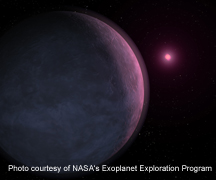Steering well clear of Mars and Phoenix, the Intute Spotlight this month falls on the smallest planet yet discovered beyond our Solar System. An international team of astronomers led by David Bennett of the University of Notre Dame, Indiana, found a planet a mere three times as massive as the Earth orbiting a brown dwarf, a kind of star itself apparently too small to sustain the nuclear fusion reactions that power stars like the Sun.
The team presented their results in detail at the American Astronomical Society annual meeting in St. Louis, Missouri, at the beginning of June. The planet, which goes by the technical name of MOA-2007-BLG-192Lb, is 3000 light years from Earth and orbits the lowest mass host star found to have a companion. Because of small measurement uncertainties in the observations, the brown dwarf may be slightly bigger, 8 percent of a solar mass, as opposed to the measured 6% and so could be a very low-mass hydrogen burning star rather than a brown dwarf.

David Bennett
Our discovery indicates that even the lowest mass stars can host planets, Bennett says, No planets have previously been found to orbit stars with masses less than about 20% of that of the Sun, but this finding suggests that we should expect very low-mass stars near the Sun to have planets with a mass similar to that of the Earth. The discovery means that NASA’s planned James Webb Space Telescope might one day be used to search for signs of life on Earth-mass planets orbiting low-mass stars in our galactic neighbourhood.
The primary challenge in microlensing measurements is precise alignment of instrumentation because the microlensing signals are quite rare and brief, often lasting less than a day. The astronomers made use of the new MOA-II telescope at New Zealand’s Mount John Observatory, using the MOA-cam3 camera, to record images of the night sky over an area 13 times larger than the area of the full moon in a single image.

Artistic view of a world unknown (Credit: NASA)
The new MOA telescope-camera system allows us to monitor virtually all of the known microlensing events for planetary signals, Bennett explains, We would not have made this discovery without it. He adds, that I’ll hazard a guess that the first extra-solar Earth-mass planet will be found by microlensing. But we’ll have to be very quick to beat the radial velocity programs [an alternative detection method] and NASA’s Kepler mission, which will be launched in early 2009.
Further reading
Astrophys J., 2008, in press
http://adsabs.harvard.edu/abs/2008arXiv0804.1354D (preprint)
David Bennett homepage
http://physics.nd.edu/Faculty/bennett.html
Suggested searches
gravitational lensing
exoplanets